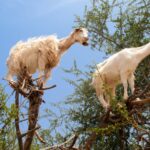CTRL+K
CTRL+K
The sight of goats perched in argan trees is an iconic image of Morocco, captivating tourists and symbolizing the unique charm of the Souss Massa region. This phenomenon, often linked to the production of the prized argan oil, is shrouded in myths and misconceptions. This post aims to demystify the true relationship between these goats and argan trees.
Visitors to Morocco are often told a fascinating tale: goats consume the fruit of the argan tree, and the nuts, passing through their digestive system, are then collected and used to produce argan oil. This narrative, while intriguing, oversimplifies and misrepresents the process.
Research conducted by Spanish and Portuguese scientists, published in “Frontiers in Ecology and the Environment,” sheds light on the actual dynamics at play. The study reveals that goats indeed climb argan trees to feed on their fruit, but rather than digesting the nuts whole, they often spit them out. This regurgitation aids in the dispersal of argan seeds, challenging the popular myth.
The goats’ unique feeding habit plays a crucial role in the lifecycle of the argan forest. By spitting out the seeds, they contribute to the natural propagation of argan trees, enhancing the forest’s density and health. This interaction exemplifies the intricate balance of the ecosystem in the region.
The image of tree-climbing goats has become more than just a curiosity; it attracts tourists, boosting local economies. Furthermore, argan oil, known for its cosmetic and culinary value, remains a vital component of Morocco’s economy. Traditional methods of argan oil extraction, respecting both cultural heritage and the environment, continue to be celebrated and preserved.
Understanding the true nature of the interaction between goats and argan trees enriches our appreciation for Morocco’s cultural and ecological landscape. It reminds us of the importance of questioning popular narratives and highlights the harmony between traditional practices and ecological truths.



There are no results matching your search.
Reset